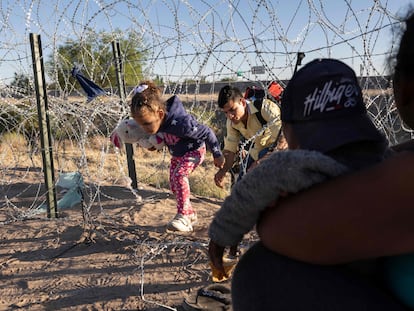Confusion reigns at US-Mexico border as end of Title 42 looms
El Paso and Ciudad Juárez, which have seen a surge in border crossers in recent days, are bracing for a migration crisis with unpredictable consequences
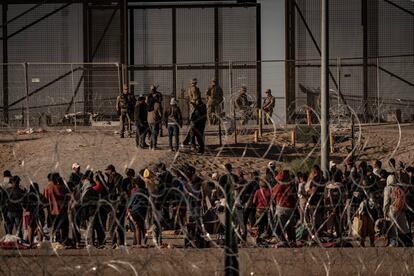
On the other side of the 20-foot high, rust-colored fence, around 500 migrants who had managed to cross the Rio Grande and turned themselves in to border authorities awaited their fate under a merciless sun on Tuesday morning at Gate 42, one of the busiest points of entry on the 1,951-mile border that separates Mexico from the United States. On the U.S. side, a burly border patrol officer who asked not to be identified confirmed that crossings between Ciudad Juárez and El Paso have surged in the last week.
It is estimated that the number of border crossers stopped each day has risen from 6,000 to 8,000, and many more are expected after 11:59 p.m. (ET) on Thursday, when Title 42 expires. Nobody on either side of the border dared to predict what exactly will happen on Friday, when the Trump-era policy that allowed border officials to immediately expel migrants ends, and regular administrative processing regulations go back in place, allowing migrants to once again seek asylum.
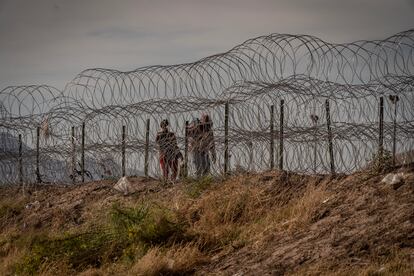
Title 42 was introduced by former president Donald Trump in 2020, allegedly as a measure to stop the spread of the Covid pandemic. From March 2020 to March 2023 it was used to immediately send 2.6 million people back to Mexico without the usual immigration court proceedings. When Title 42 — part of the Public Health Service Act of 1944 — ends, Title 8 will go back into effect. In practice, this will introduce tougher requirements to enter the United States. Those denied entry will be deported, and be barred from attempting entry again for the following three, five or eight years. If they are caught trying again, they face prison terms in the United States. By comparison, under Title 42, deported migrants could keep trying without any consequences.
“On Thursday nothing will end; a harsher era of arrests, deportations and imprisonment is being inaugurated. And the most worrying thing is that this will include refugees, people who legitimately have the right to seek asylum,” says Fernando García, executive director of the Border Network for Human Rights, a non-profit that has been working in the field for 25 years.
The apocalyptic forecast made by the hardest wing of the Republican Party assumes that the border will be thrown wide open on Thursday, and that an invasion will be inevitable. “Disinformation spread for different reasons by Republicans and human smugglers is leading many to believe that it will be easier now than ever to get in. I am afraid that thousands of people waiting on the other side will try their luck. If one stops to think about it, there is an extraordinary paradox in the way conservatives are encouraging these attempts,” says García.
Authorities estimate there could be upwards of 10,000 daily arrests as of Friday. Holding centers are already stretched to the limit, with around 25,000 migrants in custody. On Tuesday, during a call between Biden and his Mexican counterpart, Andrés Manuel López Obrador, the leaders discussed ways to “urgently reduce overcrowding” in the region.
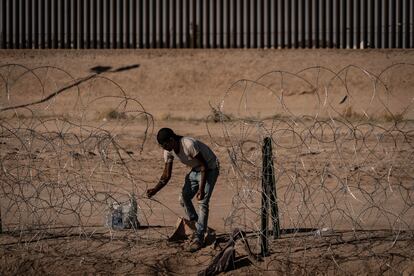
The Biden administration has been bracing for a crisis for weeks, and spent several days trying to prove it has the situation under control. It has sent 1,500 active-duty troops to the border, in addition to the 2,500 that are already stationed along the busiest border on the planet. The new troops will not participate in security tasks, which are the exclusive responsibility of the border police; instead, they will provide logistical and administrative support.
These efforts are focused on three concepts, as two White House officials told reporters on Tuesday: “law enforcement, deterrence and diplomacy.” “We have provided more resources, we have sent more troops and officers for the processing of migrants, judges and lawyers to help expand legal channels for immigration,” they explained. The diplomacy part involves the promise to open processing centers in Guatemala and Colombia with the collaboration of allies such as Spain and Canada, as well as the launch of a mobile application, CBP One, intended to help migrants apply for asylum from their countries of origin. But migrants have criticized it because, they say, navigating the app requires the kind of knowledge that only a combination of lawyer and computer scientist might have, and which most applicants lack.
Despite these efforts, the situation has placed Biden in a delicate situation. As a candidate, he campaigned on a promise to humanize immigration management, but in practice he has continued on the path set by Trump. The president now finds himself sandwiched between those who consider him too soft on border issues and those who blame him for being too harsh.
The human face of that political fight can be seen at the Sacred Heart Church in downtown El Paso (population 1.45 million). This town has become ground zero for the immigration crisis. It was already filled with people living on the streets in May and December, when judges twice stopped the government from ending Title 42. The entire block where the church sits has been fenced off to prevent migrants from leaving those four streets, and has housed up to 2,000 people, including dozens of small children. They crossed here from Ciudad Juárez in search of a better future than the one awaiting them in their countries of origin. On Tuesday morning, there were about 1,000 people still living there.
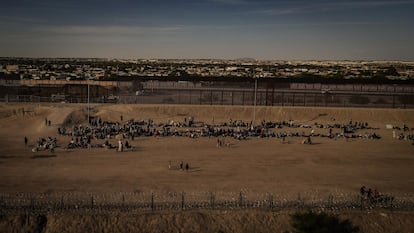
Venezuelans and Colombians are the predominant nationalities. Some have been there for weeks, others have just arrived. They sleep outdoors with blankets provided by the Red Cross and seek the shade during the day, now that temperatures are already close to 86ºF (30ºC). They share terrifying stories of journeys through the Darién jungle, one of the most dangerous passes in the world, where murders, rapes, beatings and extortion are rife.
Early on Tuesday, a few individuals without uniforms began distributing leaflets among the waiting migrants, encouraging those who crossed “the border between the international bridges” (a euphemism for “illegally”) to go to their nearest U.S. Customs and Border Patrol station for “processing.” A day earlier, the Department of Homeland Security had warned about an upcoming “localized operation of law enforcement,” which many automatically translated as “raid.” Venezuelan migrant Yirmin López was thinking of taking a bus to Denver that same day, while Carlos Mario, a Colombian national, quoted Chronicle of a Death Foretold, a novel by Gabriel García Márquez, to explain that he had no intention of surrendering to authorities. “They will send me back to my country,” he said. Among the luckiest were Joana Guerra and her children, Brittany, five, and Zander, three. The family did report to the authorities, and have permission to travel to New York to stay with relatives.
Meanwhile, in the Mexican border city of Ciudad Juárez (population: 1.5 million), an estimated 35,000 migrants are at an impasse. Many are in makeshift camps just a few feet from the Rio Grande, the natural border between the two countries. The migrants wait there in the hopes that U.S. authorities will pick them up for processing. The last time this happened was May 2. Since then, hundreds of people have waited with a number painted on their forearms indicating their place in line in case this happens again.
The flow between Ciudad Juárez and El Paso is one of the most intense on the border. Irregular crossings have increased by 134% in the first seven months of the fiscal year (October to September), compared to 2022. More than 235,000 people have been intercepted there since last October. There are other busy crossing points: Tijuana (15,000 people), Yuma in Arizona, where 1,000 cross every day, and Matamoros, which connects with the easternmost part of Texas, where on Sunday an individual ran over a group of immigrants with his truck, killing eight people.
Official shelters are close to collapse. Local authorities in Ciudad Juárez said on Tuesday that there were 900 spots left in a system with a capacity for around 3,000. Calls for help have come in from smaller Mexican border communities that lack the infrastructure of the bigger cities and who fear being inundated by migrants deported by the U.S. in the coming days.
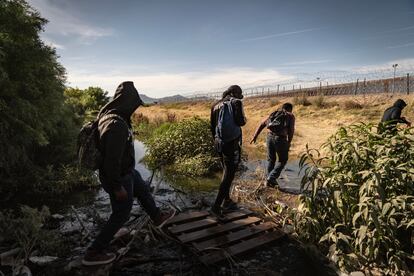
Officials in Washington estimate that more than 150,000 migrants were waiting this weekend in shelters and on the streets of Mexico’s northern states, a source familiar with the estimates told CNN. The figure easily exceeds the number that the Mexican government has pledged to accept, around 30,000 people.
Sign up for our weekly newsletter to get more English-language news coverage from EL PAÍS USA Edition
Tu suscripción se está usando en otro dispositivo
¿Quieres añadir otro usuario a tu suscripción?
Si continúas leyendo en este dispositivo, no se podrá leer en el otro.
FlechaTu suscripción se está usando en otro dispositivo y solo puedes acceder a EL PAÍS desde un dispositivo a la vez.
Si quieres compartir tu cuenta, cambia tu suscripción a la modalidad Premium, así podrás añadir otro usuario. Cada uno accederá con su propia cuenta de email, lo que os permitirá personalizar vuestra experiencia en EL PAÍS.
¿Tienes una suscripción de empresa? Accede aquí para contratar más cuentas.
En el caso de no saber quién está usando tu cuenta, te recomendamos cambiar tu contraseña aquí.
Si decides continuar compartiendo tu cuenta, este mensaje se mostrará en tu dispositivo y en el de la otra persona que está usando tu cuenta de forma indefinida, afectando a tu experiencia de lectura. Puedes consultar aquí los términos y condiciones de la suscripción digital.
More information
Archived In
Últimas noticias
Most viewed
- Reinhard Genzel, Nobel laureate in physics: ‘One-minute videos will never give you the truth’
- Oona Chaplin: ‘I told James Cameron that I was living in a treehouse and starting a permaculture project with a friend’
- Pablo Escobar’s hippos: A serious environmental problem, 40 years on
- Why we lost the habit of sleeping in two segments and how that changed our sense of time
- Chevy Chase, the beloved comedian who was a monster off camera: ‘Not everyone hated him, just the people who’ve worked with him’
